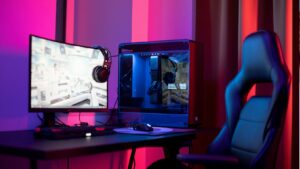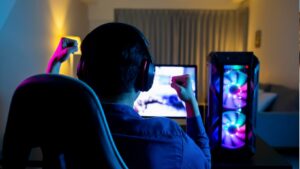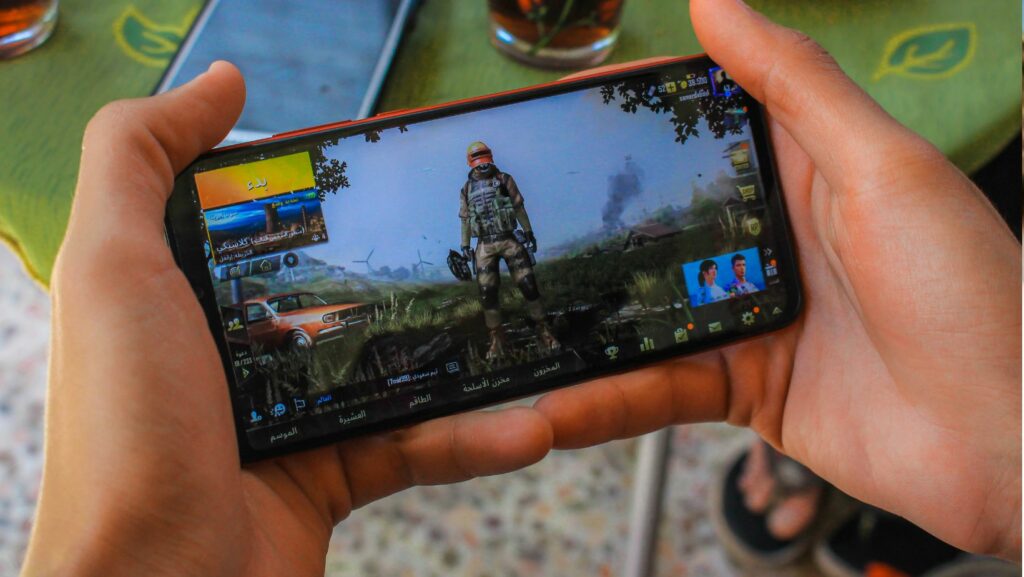Gaming PC Tips
Gaining insights into gaming PC basics provides a sturdy foundation for enhancing the gaming experience. Here is a look at some fundamental components.
Every gaming PC’s strength predominantly lies within two principal components: the Central Processing Unit (CPU) and the Graphics Processing Unit (GPU). The CPU, also referred to as the computer’s brain, focuses on executing instructions from a computer’s hardware and software. Its speed, in Gigahertz (GHz), often determines how quickly it performs tasks.

Contrarily, the GPU concentrates almost exclusively on rendering images and videos. It’s essential for a smoother, lag-free gaming experience. For instance, NVIDIA and AMD are popular GPU manufacturers revered for their performance in modern gaming rigs.
Random Access Memory (RAM) is another crucial component in a gaming PC. RAM serves as a form of temporary storage that the CPU can access rapidly. It’s essential for multitasking or handling complex game sequences. Moreover, a hefty amount of RAM (8GB to 16GB) allows a gaming PC to handle heavier loads, leading to an improved gaming performance. Crucial, Kingston, and Corsair are three popular RAM manufacturers known for their high-quality products.
Essential Gaming PC Tips
In a continuous endeavor for enhanced gaming performance, the following tips come in handy. They will aid in achieving smoother gameplay, richer visuals, and a more immersive gaming experience.
To get more out of a gaming PC, upgrading specific hardware components often makes a big difference. Regularly updating the graphic card offers significant improvements in rendering game visuals. For instance, cards like NVIDIA’s GeForce RTX series or AMD’s Radeon RX series deliver exemplary graphic performance, enhancing the gamer’s experience.
Upgrading the CPU also contributes to better performance. Intel’s Core i7 and i9 series or AMD’s Ryzen series are popular choices for gaming, offering impressive instructions per clock (IPC) performance.

Increasing RAM contributes to smoother gameplay, particularly when running memory-intensive games. As previously mentioned, a range of 8GB to 16GB is preferable, with brands like Crucial, Kingston, and Corsair offering reliable and fast-performing RAM modules.
Overclocking, pushing CPU and GPU beyond their designated limits, amplifies the power and overall performance of a gaming PC. However, it involves a certain level of risk and requires careful handling to prevent overheating and system instability.
Starting the overclocking process, invest in a high-quality cooling system. Liquid coolers, for example, prove more effective than air coolers at dealing with the extra heat generated by overclocking. Software tools like MSI Afterburner for GPU and Intel Extreme Tuning Utility for CPU provide precise control for dialing in the ideal overclock settings.
Before proceeding, closely monitor system temperatures during stress tests. If the system is stable and the temperatures are within safe limits, a small increase in the overclock settings is possible. If instability is detected, dial back the overclock settings immediately.
Optimal Graphics Settings for Better Gaming
Mastering graphics settings in games proves crucial in heightening gaming experiences. This section focuses on understanding and tweaking these settings for achieving optimal performance.
Graphics settings influence how games look and play. For instance, ‘Resolution’ determines game clarity, with Full HD (1920×1080), Quad HD (2560×1440), and 4K (3840×2160) as common options. ‘Anti-aliasing’ smooths jagged edges, while ‘Texture Quality’ impacts surface detail.

‘Shadow Quality’ modifies in-game shadow details, and ‘Ambient Occlusion’ affects how light interacts with objects. Recognizing these settings, gamers understand and gauge the graphical workload on their PC.
Adjusting graphics settings optimizes game performance. Begin by setting the desired ‘Resolution’, but remember, higher resolutions demand more processing power. Turn off ‘Anti-aliasing’ or set it on lower settings if facing performance issues. Adjust ‘Texture Quality’ to a medium setting, as it doesn’t necessarily impede performance, but drastically enhances visuals. Tweak ‘Shadow Quality’ and ‘Ambient Occlusion’, as they can be taxing on the GPU if set too high. Once done, verify these changes during gameplay. If the game runs smoothly, consider gradually increasing settings. Striking this balance results in captivating visuals without compromising game performance.



